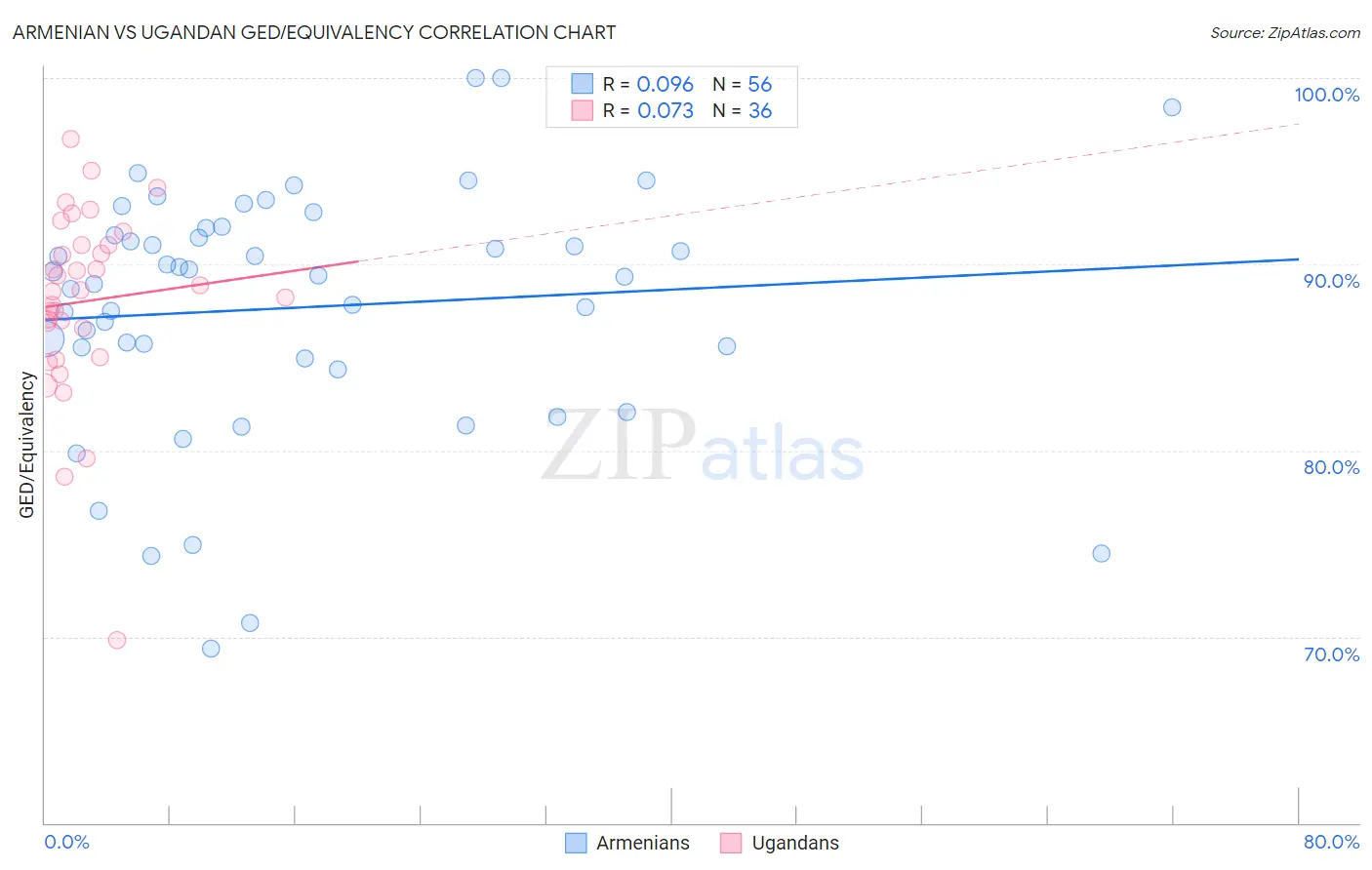Armenian vs Ugandan GED/Equivalency
COMPARE
Armenian
Ugandan
GED/Equivalency
GED/Equivalency Comparison
Armenians
Ugandans
86.3%
GED/EQUIVALENCY
76.4/ 100
METRIC RATING
154th/ 347
METRIC RANK
86.1%
GED/EQUIVALENCY
66.3/ 100
METRIC RATING
163rd/ 347
METRIC RANK
Armenian vs Ugandan GED/Equivalency Correlation Chart
The statistical analysis conducted on geographies consisting of 310,954,685 people shows a slight positive correlation between the proportion of Armenians and percentage of population with at least ged/equivalency education in the United States with a correlation coefficient (R) of 0.096 and weighted average of 86.3%. Similarly, the statistical analysis conducted on geographies consisting of 94,018,260 people shows a slight positive correlation between the proportion of Ugandans and percentage of population with at least ged/equivalency education in the United States with a correlation coefficient (R) of 0.073 and weighted average of 86.1%, a difference of 0.26%.

GED/Equivalency Correlation Summary
| Measurement | Armenian | Ugandan |
| Minimum | 69.3% | 69.8% |
| Maximum | 100.0% | 96.7% |
| Range | 30.7% | 26.9% |
| Mean | 87.7% | 88.0% |
| Median | 89.3% | 88.6% |
| Interquartile 25% (IQ1) | 85.3% | 85.8% |
| Interquartile 75% (IQ3) | 91.8% | 91.0% |
| Interquartile Range (IQR) | 6.5% | 5.2% |
| Standard Deviation (Sample) | 6.7% | 5.1% |
| Standard Deviation (Population) | 6.7% | 5.0% |
Demographics Similar to Armenians and Ugandans by GED/Equivalency
In terms of ged/equivalency, the demographic groups most similar to Armenians are Kenyan (86.3%, a difference of 0.0%), Brazilian (86.3%, a difference of 0.020%), Iraqi (86.2%, a difference of 0.030%), Immigrants from Bosnia and Herzegovina (86.3%, a difference of 0.040%), and Immigrants from Western Asia (86.3%, a difference of 0.070%). Similarly, the demographic groups most similar to Ugandans are Venezuelan (86.0%, a difference of 0.020%), Immigrants from Iraq (86.1%, a difference of 0.040%), Alsatian (86.0%, a difference of 0.040%), Immigrants from Albania (86.0%, a difference of 0.050%), and Ethiopian (86.0%, a difference of 0.060%).
| Demographics | Rating | Rank | GED/Equivalency |
| Immigrants | Poland | 79.3 /100 | #148 | Good 86.3% |
| Menominee | 79.3 /100 | #149 | Good 86.3% |
| Immigrants | Western Asia | 78.8 /100 | #150 | Good 86.3% |
| Immigrants | Bosnia and Herzegovina | 77.9 /100 | #151 | Good 86.3% |
| Brazilians | 77.2 /100 | #152 | Good 86.3% |
| Kenyans | 76.6 /100 | #153 | Good 86.3% |
| Armenians | 76.4 /100 | #154 | Good 86.3% |
| Iraqis | 75.2 /100 | #155 | Good 86.2% |
| Immigrants | Nepal | 73.3 /100 | #156 | Good 86.2% |
| Whites/Caucasians | 72.2 /100 | #157 | Good 86.2% |
| German Russians | 72.1 /100 | #158 | Good 86.2% |
| Immigrants | Kenya | 71.8 /100 | #159 | Good 86.2% |
| Immigrants | Morocco | 69.5 /100 | #160 | Good 86.1% |
| Immigrants | Syria | 69.3 /100 | #161 | Good 86.1% |
| Immigrants | Iraq | 68.1 /100 | #162 | Good 86.1% |
| Ugandans | 66.3 /100 | #163 | Good 86.1% |
| Venezuelans | 65.5 /100 | #164 | Good 86.0% |
| Alsatians | 64.3 /100 | #165 | Good 86.0% |
| Immigrants | Albania | 64.2 /100 | #166 | Good 86.0% |
| Ethiopians | 63.7 /100 | #167 | Good 86.0% |
| Sierra Leoneans | 61.8 /100 | #168 | Good 86.0% |